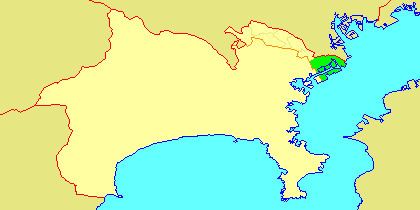Area 39.21 km² Population 216,826 (Mar 2010) | Region Kantō Established April 1, 1972 Local time Saturday 6:06 PM | |
 | ||
Weather 9°C, Wind N at 14 km/h, 55% Humidity Points of interest Kawasaki Daishi, Tokyo Bay Aqua‑Line, Daishi Park, Chidori Park, Fujimi Park | ||
Kawasaki temple
Kawasaki-ku (川崎区) is one of the seven wards of the city of Kawasaki in Kanagawa Prefecture, Japan. As of 2010, the ward had an estimated population of 216,826 and a density of 5,530 persons per km². The total area was 39.21 square kilometres (15.14 sq mi). Kawasaki-ku has the home to the second largest Koreatown in Japan.
Contents
- Kawasaki temple
- Map of Kawasaki Ward Kawasaki Kanagawa Prefecture Japan
- Geography
- Surrounding municipalities
- History
- Economy
- Education
- Rail
- Road
- Local attractions
- Noted people from Kawasaki Ward
- References
Map of Kawasaki Ward, Kawasaki, Kanagawa Prefecture, Japan
Geography
Kawasaki Ward is located in northeastern Kanagawa Prefecture, in the northeast portion of the city of Kawasaki, bordering on the Tama River and Tokyo to the north and Tokyo Bay to the south and east. Much of the land area of the Ward is reclaimed land
Surrounding municipalities
History
Under the Nara period Ritsuryō system, what is now Kawasaki Ward became part of Tachibana District Musashi Province. In the Edo period, it was administered as tenryō territory controlled directly by the Tokugawa shogunate, but administered through various hatamoto, and prospered as Kawasaki-juku, a post station on the Tokaido highway connecting Edo with Kyoto. After the Meiji Restoration, the area urbanized with the development of Kawasaki Station on the Tokaido Main Line and became a center for heavy industry. The area was largely destroyed by the Great Kanto earthquake of 1923 and during American bombing during World War II. Kawasaki Ward was established with the division of the city of Kawasaki into wards on April 1, 1972. Long associated with grime, labor unrest, organized crime and pollution-related diseases, the local government undertook extensive efforts in the 1990s to revamp the area image.
Economy
The economy of Kawasaki Ward continues to be dominated by industry.
Education
There is a North Korean school, Kawasaki Korean Primary School (川崎朝鮮初級学校).
